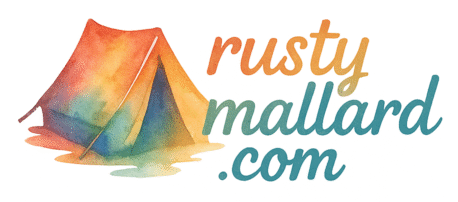Introduction: Into the Wild, But Make It Safe
Camping in the wild sounds like the perfect escape from the daily grind, right? Just you, the stars, and the sounds of nature. But here’s the deal — nature doesn’t come with a safety manual. Whether you’re a total newbie or a seasoned camper, staying safe should always be priority number one. So let’s walk through seven simple, smart ways to protect yourself while soaking in the great outdoors.
(Psst — if you’re just starting out, check out these beginner camping tips on Rusty Mallard!)
1. Choose Your Campsite Wisely
Check for hazards before settling in
Not all spots in the wild are created equal. Before you pitch that tent, do a quick scan. Look for dead tree limbs that could fall, uneven ground, signs of flooding, or fire hazards like dry grass. You want a flat, clear area that’s safe from natural threats.
Consider proximity to water and wildlife
Water sources are handy but camping too close to a river or lake can attract animals or put you in danger during sudden rainstorms. Try to keep a safe distance—about 200 feet away from water is ideal.
Explore beginner-friendly locations
If you’re new to this, start with less remote locations. Camping destinations listed on Rusty Mallard offer great options for all experience levels and often include essential safety amenities.
2. Always Tell Someone Your Plans
Create a basic itinerary
Before you head off-grid, jot down your camping plan: where you’re going, who’s with you, and when you’ll be back. Even if it’s a spontaneous trip, this one step could literally save your life.
Share emergency contact info
Give a copy of your itinerary and emergency numbers to a trusted friend or family member. That way, if something goes sideways, someone knows when and where to start looking.

3. Pack Smart with Safety in Mind
The essential gear checklist
A safe camping trip starts with smart packing. Don’t skip these essentials:
- Tent with rainfly
- Sleeping bag and pad
- Map and compass
- Flashlights and extra batteries
- Firestarter or waterproof matches
- Multi-tool
Explore more must-haves on Rusty Mallard’s gear guide.
Don’t forget a first-aid kit
A well-stocked first-aid kit is non-negotiable. Include bandages, antiseptic wipes, painkillers, tweezers, allergy meds, and insect repellent. You’d be surprised how often campers overlook this one.
Food storage to keep animals away
Wildlife loves free meals. Use bear-proof containers or hang your food from a tree. Never leave snacks in your tent! For meal ideas that are safe and tasty, check out these camping recipes.
4. Respect the Wildlife
Do not approach or feed animals
Sure, that deer might look Disney-level adorable, but feeding or approaching wild animals is a big no-no. Not only is it unsafe, but it also messes with their natural behavior.
Store food and trash properly
Animals are pros at sniffing out food. Keep all your edibles sealed and your trash packed up and far from camp. This prevents unwanted visitors like raccoons or even bears.
Learn from past camping mistakes
Want to avoid rookie errors? Browse this helpful tag: camping mistakes. You’ll find real stories and lessons that could save you trouble (and embarrassment).
5. Master the Art of Fire Safety
Build fires in designated areas only
Campfires can turn dangerous fast. Use designated fire rings if available and keep fires small. Never leave a fire unattended—ever.
Keep water or sand nearby
Always have a way to put your fire out quickly. A bucket of water, a shovel, or even sand will do the trick.
Practice survival skills safely
Want to go full Bear Grylls? That’s awesome. Just be sure your survival skills don’t put others—or the forest—at risk.
6. Stay Aware of the Weather
Check the forecast and prepare accordingly
Mother Nature can be moody. A sunny morning can turn into a stormy mess by afternoon. Always check the weather before heading out.
Pack layers and weather-appropriate gear
Even in summer, nights can get chilly. Dress in layers and bring a waterproof jacket just in case. Trust me, shivering in wet socks is not part of the rustic lifestyle.
Speaking of which, dive into the full rustic lifestyle at Rusty Mallard to learn how to embrace nature without freezing your toes off.
7. Brush Up on Basic First Aid and Survival Skills
Learn CPR and how to treat common injuries
Knowing how to stop a bleed, wrap a sprain, or administer CPR could be a game-changer. Consider taking a class before your trip.
Know how to navigate without tech
Phones die. Signals drop. Maps get soggy. Learn how to use a compass and read a physical map. It’s old-school—but it works.
More outdoor advice is just a click away.
Conclusion: Wild Adventures with a Side of Wisdom
Camping in the wild is the ultimate way to disconnect from screens and reconnect with nature. But it’s not without risks. With these 7 safety strategies in your back pocket—from smart packing and fire safety to respecting wildlife and staying weather-aware—you can focus on what really matters: the thrill of the outdoors.
Ready to dive deeper? Check out everything from camping tips to nature education over at Rusty Mallard.
FAQs
Q1: What’s the safest distance to camp from water?
A: Around 200 feet. It helps prevent flooding risks and reduces animal encounters.
Q2: Do I really need a compass if I have a phone?
A: Yep. Phones can die or lose signal. A compass doesn’t.
Q3: What’s the best way to avoid wild animals?
A: Keep food sealed, don’t leave trash out, and never approach or feed wildlife.
Q4: What’s one common mistake campers make?
A: Not telling anyone their plans. Always let someone know your route and return time.
Q5: Should I worry about the weather in summer?
A: Absolutely. Storms and cold nights can surprise you. Always check the forecast and pack layers.
Q6: Are beginner-friendly campsites better for safety?
A: Totally. They often include extra resources and easier terrain—perfect for learning the ropes.
Q7: Where can I find more beginner camping info?
A: Right here at Rusty Mallard. It’s packed with practical tips and real-world advice.


